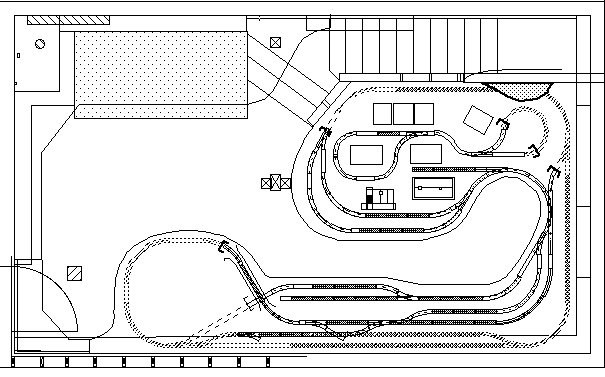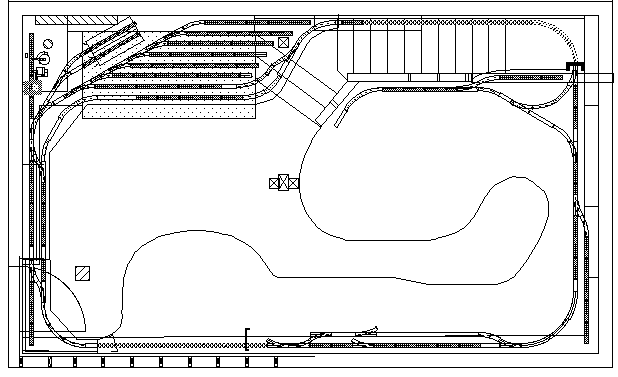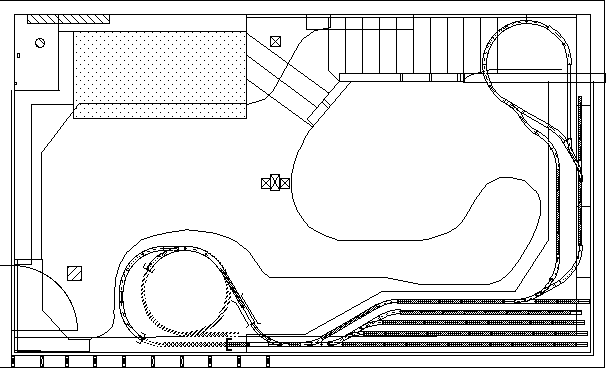
This is a diagram of the inner line of the GIRR Mountain Division. Track in dotted lines is hidden. The elevation of the inner line ranges between 50" and 59" from the floor.
The trolley line is flex track bent to a 1' radius. The Bachmann trolley can deal with this radius, barely anyway. Trolley control can be either fully automatic or manual. The trolley makes two timed stops in town with controlled deceleration and acceleration and then makes a much longer (up to 5 minute) stop in the hidden section. The reversing loops are one way with spring switches.
The maximum grade on the inner line is 4.2% which restricts train length to an average of 4 or 5 cars. Curves are almost all 2' radius with one section at 2.5'.
The track is a combination of LGB sectional and flex track and Aristo sectional track. As far as I can tell, the two types are functionally interchangeable. Being indoors, track cleaning is required maybe once a year since all the wheels are metal from San-Val. Turnouts are all 1200 type with all of the left turnouts being LGB and most of the right turnouts being Aristo. This is just an artifact of what was available at San-Val the day that I bought much of the track.

This is the outer or main line which is wrapped around the room. Most of this line is about 9" to 12" above the inner line (59" to 62" from the floor) except at the interchange where the inner line rises to meet the outer line. The interchange track is split between the inner and outer line drawings at the lower center of the drawings.
Grades on the outer line are 1.5% maximum with most curves being 2' radius. Train lengths can exceed 20 cars with the limiting factor being train straightening in the curves.

This is the upper line. It connects to the other two lines at the interchange and then climbs a 1 3/4 turn spiral inside the mountain. This puts it 77" from the floor so that a stepladder is required to view this level. The mountain is hollow with clear access inside to all the hidden track. The loop at the other end also has access from inside the loop.
The reversing loops are conventional one way loops with spring switches. Reversing control on the loops is handled by a home-brew intelligent auto reversing controller which senses train presence at the exit of the loops and determines if the main line should be reversed or not.
The grade in the spiral is 5.2% on a 4' diameter curve. This restricts train length on this grade. A Bachmann 2-4-2 will barely handle one car, a weighted Big Hauler will handle 3, an LGB 0-4-0 with a powered tender will handle 5, and the Shay will handle 8.
I've received some questions about how I created these drawings. I used MacDraw Pro on a Macintosh (mostly done on PowerBook 100) to create these drawings. I drew custom track templates for sectional track and copied and moved them around as necessary. Track elements lock on a 0.5 cm grid (the drawings are metric) so lining up things is easy.
The rest of the drawings were done with the MacDraw Pro drawing elements on a 0.5 cm grid. All basement measurements were made very accurately and even some non-square corners are handled properly. The drawings include about 200 individual layers that can be stacked and shown in any order. These layers include the basement, plumbing, house framing where important, blocked or restricted access areas, layout framing, layout roadbed, track, equipment clearances, wiring, structures, significant scenic elements, wiring diagrams, operational notes, in short, everything significant
Doing the drawings with CAD was a real boost as they came out so accurately, I could cut wood and track by the numbers and fully expect them to fit.
I subsequently tried to use CadRail (my PowerMac does Windows too) to do my outdoor layout and had to give it up. The program was inflexible, frustrating and didn't allow me to add the other associated graphics as I wanted.
I did use Design Your Own Railroad to do operational tests. As a CAD tool DYOR is fully useless, but it does do a credible job in testing how a layout will work operationally and it helped me refine my plans while it was easy.
Clearances to walls and other obstructions are tight. I designed it to clear a Big Hauler, the largest engine that I envisioned using. This vision turned out to be myopic as I've had to make adjustments over the years for larger equipment. However, with the exception of vertical clearance, the Shay did fit with only very minor adjustments. My hard vertical clearance limit is 7 1/4" from the rail head and the Shays weren't close to that. I replaced the stacks (with ones ripped off old RC Big Haulers) and cut a 1/4" sections out of the middle of the steam domes to make them fit. If your layout will clear a Big Hauler, it can probably clear a Shay.
These same old RC Big Haulers have surrendered their sound circuits to the Shays. The sound is basic, but its better than whirring gears and costs considerably less than commercial sound systems.
Turnouts in both yards and the interchange are each controlled by an interlocking route control systems such that only one control panel switch is thrown to align all the turnouts to set up a complete route through that particular trackwork. In the interchange, up to ten turnouts are thrown with one command. This system has practically eliminated derailments due to misaligned turnouts and I rarely find a need to check the aspect of any turnouts.
In the yards, power is also automatically routed to the selected track. In the interchange, power control is automatically transferred between power packs so that control is continuous throughout the trackwork. When the lines are not interconnected, each line has its own power pack. When lines are interconnected, there is a hierarchy which defines which pack takes over control of which line.
Even thought this layout is small, I use an Aristo Train Engineer on the main power pack. I find that the freedom to walk around with a train really enhances operational enjoyment. I haven't yet connected the Train Engineer to the interlocking control system (as I have done in my outdoor layout) but I might later. I might also eventually convert to DCC if I can find a system without a tether. Check back in a couple of years.